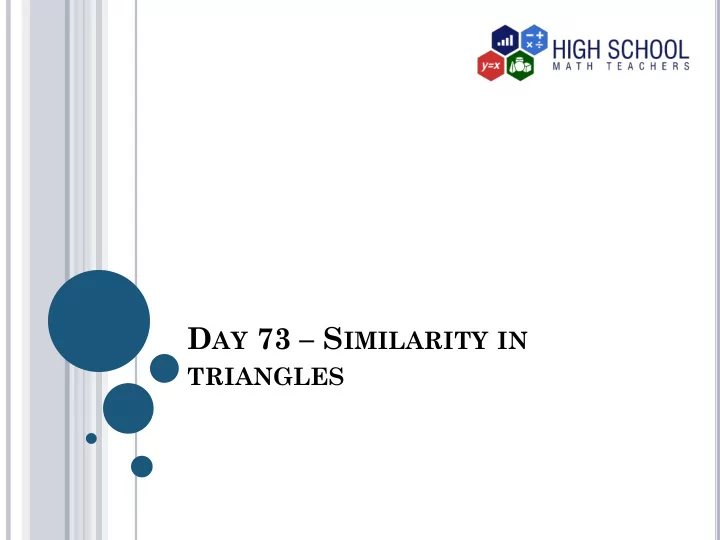

D AY 73 – S IMILARITY IN TRIANGLES
I NTRODUCTION We have discussed triangle congruence in previous lessons and how to identify congruent triangles. We also have plane figures which have the same shape but not necessarily the same size. Such figures are said to be similar. The idea of similar figures is applied in real life to measure heights and lengths indirectly, for example, the height of a mountain or a tree. A dilation transforms plane figures to similar plane figures. In this lesson, we are going to explore the similarity of triangles based on corresponding angles and sides.
V OCABULARY 1. Similar triangles Triangles that have the same shape but not necessarily the same size 2. Corresponding parts Sides or angles that are in the same position relative to one another. 3. Scale factor The ratio of the lengths of the corresponding sides of similar plane figures.
4. Ratio The relative magnitude of two measurements (or quantities), usually expressed as a fraction. 5. Proportion A fraction that compares two equivalent ratios.
S IMILARITY IN TRIANGLES Two or more triangles are said to be similar if they have the same shape but not necessarily the same size. If two triangles are similar, we say that one is a scale model of the other. It is worth noting that congruent triangles are also similar. We can generally say that, all congruent triangles are similar, but all similar triangles need not be congruent. We use the symbol ~ to show that two triangles are similar, for example, if ΔABC is similar to ΔPQR , we write ΔABC~ΔPQR .
Properties of similar triangles 1. Their corresponding angles are congruent 2. The lengths of corresponding sides are in the same proportion or ratio 3. They have the same shape but not necessarily the same size.
In the figure below ΔABC~ΔPQR . A P R Q B C
The three pairs of corresponding angles are congruent: ∠A ≅ ∠P ∠B ≅ ∠Q ∠C ≅ ∠R The corresponding sides are in the same proportion or ratio: AB PQ = BC QR = AC PR
We may also have similar triangles in one triangle where one triangle overlaps the other. P S T Q R
In the figure above ΔPQR~ΔPST in such that ΔPST is overlapping triangle. We should also note that ST ∥ QR and ∠P is shared between the two triangles The other two pairs of corresponding angles are congruent: ∠S ≅ ∠Q ∠T ≅ ∠R The corresponding sides are in the same proportion or ratio: PQ PS = PR PT = QR ST
Example Find the value of 𝑦 given that two triangles are similar. 2𝑦 + 4 8 2𝑦 − 2 6
Solution Since the triangles are similar, the corresponding sides are in the same proportion or ratio 2𝑦 + 4 = 2𝑦 − 2 8 6 Cross multiplying and solving 8 2𝑦 − 2 = 6 2𝑦 + 4 16𝑦 − 16 = 12𝑦 + 24 16𝑦 − 12𝑦 = 24 + 16 4𝑦 = 40 𝒚 = 𝟐𝟏
HOMEWORK Given that NP ∥ LM , identify two similar triangles and hence find the side length represented by 𝑦 in the figure below. K 3 𝑦 N P 6 L M 12
A NSWERS TO HOMEWORK ΔKNP~ΔKLM 𝑦 = 4
THE END
Recommend
More recommend